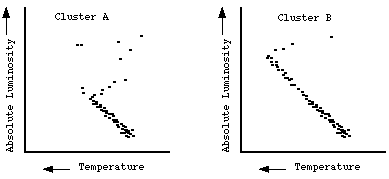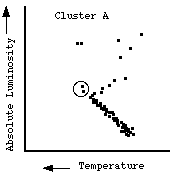Physics 20083 - Introductory Astronomy - Summer 2004
Exam 3
Answer any 7 of the following 8 questions. All relevant equations have been given on the cover page (not visible in WWW version).
Each is worth 14 points.
1) Much of our research in Astronomy inevitably returns to the study of life's origin.
- a) (7 pts) The heavy elements found on the Earth (and in all life on Earth) all originated in the supernova explosion of a star. Explain how we know this, and also explain how the elements are formed in a supernova.
- b) (7 pts) One thing that makes our species unique among life on Earth is our intelligence. What argument can you make that evolution is very unlikely to result in intelligent life?
2) One of the first black holes ever "discovered" by Astronomers lay within the constellation Cygnus. The object is called Cygnus X-1.
- a) (8 pts) Sketch a simple diagram of the stars in this constellation, name one of the bright stars in Cygnus and then state where it can be found in the sky at about 10pm tonight (altitude and azimuth).
- b) (6 pts) Explain how Astronomers can prove the existence of a black hole when it is the central star in a binary system, even though we cannot directly observe the black hole.
3) Late in a star's life, it will begin to fuse elements in its core that are heavier than Hydrogen, such as Helium.
- a) (6 pts) Explain why Helium fusion in the core of a star requires a higher density and temperature compared to Hydrogen fusion (the proton-proton chain).
- b) (8 pts) The onset of Helium fusion often leads to a planetary nebula in a star. Explain more specifically what causes the planetary nebula, and explain why very massive stars (much more massive than our Sun) tend to avoid this fate.
4) One of the strangest signals we hear is that of pulsars. However, if we could observe Earth from far away, we would also detect a very strange signal.
- a) (6 pts) Explain how the Earth's signal would appear to some distant Astronomer 20 light years away. Aside from being weaker thanks to the inverse square law, how would this signal have different characteristics if viewed from even further way, like 50 light years? Explain.
- b) (8 pts) One type of unusual pulsar is called a "magnetar", thought to be the source of unusually strong gamma-ray outbursts in the sky. Explain how and why these outbursts can be detected simply by monitoring the Earth's ionosphere.
5) Astronomers compile data on the stellar properties in two clusters of stars, shown below on H-R diagrams. Answer (and explain your answer for) each of the following questions: Which cluster is older? Which cluster has a higher metallicity?

6) In cluster A, a little circle has been drawn around a couple of stars on the diagram. These are called "blue stragglers". Explain what these stars are, and explain why they seem to evolve differently from ordinary stars.

7) The Milky Way disk has a blue color and rotates in such a way that the spiral arm pattern can be maintained for many turns of the galaxy. Each of these two properties has an interesting story behind it.
- a) (7 pts) Explain why the disk of the Milky Way is blue while other parts of the galaxy (the nucleus and halo) have a redder color.
- b) (7 pts) Explain why the inner parts of the galactic disk rotate just as quickly as the outer parts (which is contrary to the way, for example, the planets orbit the Sun in the solar system, with the innermost planets moving much more quickly).
8) Two methods we have looked at for determining the distances to galaxies are the Tully-Fisher relation and the standard ruler method.
- a) (7 pts) Explain step-by-step how we use the Tully-Fisher (TF) relation to find the distance to edge-on spiral galaxies. Also, explain why this method is limited to only nearby spiral galaxies.
- b) (7 pts) The standard ruler (SR) method is not distance limited. Explain how we use the SR technique to find distances to other galaxies. Why is this method not very reliable?


